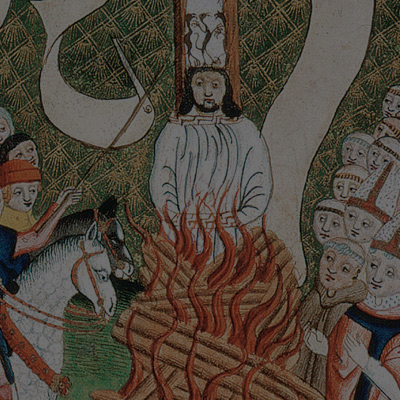Moravian Origins
Moravian Origins | North Carolina: A New Home | A Center of Commerce and Trade | The First Sisters | Bethabara’s Enslaved | Moravians at War
 “Even if I should stand before the stake, which has been prepared for me, I would never accept the reconciliation of the theological faculty.” -Jan Hus, 1412.
“Even if I should stand before the stake, which has been prepared for me, I would never accept the reconciliation of the theological faculty.” -Jan Hus, 1412.
The Moravian Church traces its origin to religious reformer Jan Hus, a controversial theologian from the Kingdom of Bohemia. He believed that everyone should be able to read and understand the Bible, so he preached in the Bohemian language rather than Latin. In 1402, Hus began his attack on the Holy Roman Church, publicly criticizing the Pope and clergy.
In 1415, the Church charged him with heresy and demanded he renounce his teachings. He refused, declaring: “I am ready to die today.” Hus was burned at the stake on July 6, 1415. After his death, his teachings spread north, reaching as far as Poland and Lithuania.
In 1457, the surviving sect of Hus’s followers became The Unitas Fratrum, or United Brethren. This group would become the Moravian Church. This radical reformation group believed that only Christ was the true head of the Church and that the Bible was the only source of truth. They attempted to simplify religion, live according to the teachings of Christ, and practice pacifism. The United Brethren established their own church and ordained their own bishops, growing to over 200,000 followers by the early 1500s.
During the Holy Roman Church’s Counter-Reformation, thousands of Brethren were killed near Prague in the Battle of White Mountain on November 8, 1620 and thousands more were expelled from Bohemia. The few who survived were forced to practice their religion in secret.
In 1722, Nicolas Ludwig, count of Zinzendorf, allowed refugees from Bohemia and Moravia to move to his estate in Berthelsdorf (modern day Saxony, Germany). The first ten Brethren to arrive started work immediately to establish the first Moravian town—Herrnhut.
While the Moravian Church flourished under Zinzendorf’s patronage, the 1730s brought renewed attacks. Other Protestant groups, like the Lutherans, saw Moravianism as a threat to their faith. Moravian missionaries were prevented from entering certain cities and were often arrested. In 1750, the Brethren were evicted. Upon hearing the news, John Carteret, Earl of Granville and Lord Proprietor of the Granville District of North Carolina, approached the Moravians about a land deal that would free them from persecution.
